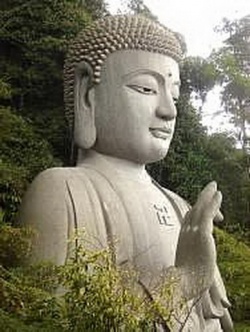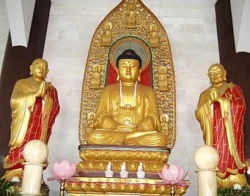Difference between revisions of "Skillful Means - Is ''The Raft'' Truly Disposable?"
(Created page with "thumb|250px| <poem> (Excerpted and revised from the 2010 December issue of The Flatbed Sutra Zen Newsletter) ... A Buddha’s discourse i...") |
|||
| Line 3: | Line 3: | ||
(Excerpted and revised from the 2010 December issue of The Flatbed [[Sutra]] [[Zen]] Newsletter) | (Excerpted and revised from the 2010 December issue of The Flatbed [[Sutra]] [[Zen]] Newsletter) | ||
... | ... | ||
| − | A [[Buddha]]’s discourse is beyond the {{Wiki|sentient}} and the {{Wiki|non-sentient}}; it is beyond the {{Wiki|relative}} and the [[absolute]]. Even so, when He became aware of [[bodhisattvas]], of ordinary {{Wiki|humans}}, of the Real Form of things, and of this discourse, He opened the Gate of [[Skillful Means]]. The Gate of [[Skillful Means]] is the unsurpassed meritorious functioning of the fruits of [[Buddhahood]]. It is the [[Dharma]] that resides in the place of [[Dharma]] and It is the form of the {{Wiki|world}} as it constantly {{Wiki|manifests}}. The Gate of [[Skillful Means]] does not refer to some momentary skill. | + | A [[Buddha]]’s {{Wiki|discourse}} is beyond the {{Wiki|sentient}} and the {{Wiki|non-sentient}}; it is beyond the {{Wiki|relative}} and the [[absolute]]. Even so, when He became aware of [[bodhisattvas]], of ordinary {{Wiki|humans}}, of the Real [[Form]] of things, and of this {{Wiki|discourse}}, He opened the Gate of [[Skillful Means]]. The Gate of [[Skillful Means]] is the [[unsurpassed]] [[meritorious]] functioning of the {{Wiki|fruits}} of [[Buddhahood]]. It is the [[Dharma]] that resides in the place of [[Dharma]] and It is the [[form]] of the {{Wiki|world}} as it constantly {{Wiki|manifests}}. The Gate of [[Skillful Means]] does not refer to some momentary skill. |
{{Wiki|Shobogenzo}}, {{Wiki|Shoho Jisso}}, {{Wiki|Hubert Nearman}} | {{Wiki|Shobogenzo}}, {{Wiki|Shoho Jisso}}, {{Wiki|Hubert Nearman}} | ||
| − | The Zen perspective of the [[Buddhist teaching]] of “[[skillful means]]” has been discussed in numerous [[Zen]] books. Not without some justification, both [[traditional]] and {{Wiki|scholarly}} accounts tend to {{Wiki|stress}} the expedient or provisional aspect of [[skillful means]], that is, are portrayed as temporary [[doctrines]] or momentary skills used to direct students to something else, something other than themselves. In short, [[skillful means]] are truly depicted as means, not ends. This view is often illustrated with the analogy of a raft; having reached the other shore (the ends), the raft (the means) should be discarded. | + | The [[Zen]] {{Wiki|perspective}} of the [[Buddhist teaching]] of “[[skillful means]]” has been discussed in numerous [[Zen]] [[books]]. Not without some [[justification]], both [[traditional]] and {{Wiki|scholarly}} accounts tend to {{Wiki|stress}} the expedient or provisional aspect of [[skillful means]], that is, are portrayed as temporary [[doctrines]] or momentary skills used to direct students to something else, something other than themselves. In short, [[skillful means]] are truly depicted as means, not ends. This [[view]] is often illustrated with the analogy of a raft; having reached the other shore (the ends), the raft (the means) should be discarded. |
| − | [[Dogen]]’s view is not so simple (nor is the view of the classic literature, but our focus is [[Dogen]]). In fact, the popular view is nearly diametrically opposed to [[Dogen]]’s own. When [[Dogen]] says a [[Buddha]]’s discourse is “beyond the {{Wiki|relative}} and the [[absolute]]” his meaning is inclusive of all {{Wiki|dualistic}} views, including “means and ends.” | + | [[Dogen]]’s [[view]] is not so simple (nor is the [[view]] of the classic {{Wiki|literature}}, but our focus is [[Dogen]]). In fact, the popular [[view]] is nearly diametrically opposed to [[Dogen]]’s own. When [[Dogen]] says a [[Buddha]]’s {{Wiki|discourse}} is “beyond the {{Wiki|relative}} and the [[absolute]]” his meaning is inclusive of all {{Wiki|dualistic}} [[views]], including “means and ends.” |
[[File:Sualization.jpg|thumb|250px|]] | [[File:Sualization.jpg|thumb|250px|]] | ||
| − | To separate “the raft” from | + | To separate “the raft” from “[[reaching the other shore]],” can only be done by violating the [[Buddhist]] {{Wiki|principles}} of {{Wiki|nonduality}}. According to these {{Wiki|principles}}, any two constituents in a {{Wiki|nondual}} relationship are [[interdependent]] – that is, they are coessential. The {{Wiki|inference}} is clear; if “the means” are provisional or momentary, “the ends” must also be provisional or momentary. For a raft to be an effective "means" for crossing a [[river]], it must be a real raft. All real [[forms]] ([[dharmas]]), according to [[Dogen]]’s teachings on [[existence]] and [[time]] (existence-time; [[uji]]), are in and of real [[time]]; thus they cannot change into unreal things, disappear, or be eliminated from [[time]] (and {{Wiki|existence}}). A raft that is truly “a means for crossing a [[river]]” is, and will always be an intrinsic aspect of “arriving at the other shore.” Likewise, if a [[verbal]] or written [[teaching]] is an effective means it must be a real [[dharma]], not a provisional one. |
| − | When [[Dogen]] speaks of “this | + | When [[Dogen]] speaks of “this {{Wiki|discourse}}” as being a “real [[form]]” he is highlighting the fact that “a [[Buddha]]’s {{Wiki|discourse}}” is a real [[dharma]]; thus, he says, “The gate of [[skillful means]] does not refer to some momentary skill.” |
| − | Therefore, by his own definition, [[Dogen]]’s {{Wiki|Shobogenzo}} (a [[Buddha]]’s discourse) is not a provisional or momentary device, but a real form ([[dharma]]) in and of space and time ({{Wiki|existence}}-time; uji); it is an {{Wiki|expression}} of [[Buddha nature]]. | + | Therefore, by his own definition, [[Dogen]]’s {{Wiki|Shobogenzo}} (a [[Buddha]]’s {{Wiki|discourse}}) is not a provisional or momentary device, but a real [[form]] ([[dharma]]) in and of {{Wiki|space and time}} ({{Wiki|existence}}-[[time]]; uji); it is an {{Wiki|expression}} of [[Buddha nature]]. |
| − | Attempting to find the “{{Wiki|reality}}” of a {{Wiki|Mozart}} {{Wiki|symphony}} independent of the actual music would not only be delusional, it would be ridiculous. This applies equally to the “{{Wiki|reality}}” of a [[Buddha]]’s discourse. Some of the most colorful expressions in {{Wiki|Shobogenzo}} are those directed at views that the “words and letters” of [[sutras]] and Zen records are mere means pointing to ends apart from themselves. | + | Attempting to find the “{{Wiki|reality}}” of a {{Wiki|Mozart}} {{Wiki|symphony}} independent of the actual {{Wiki|music}} would not only be delusional, it would be ridiculous. This applies equally to the “{{Wiki|reality}}” of a [[Buddha]]’s {{Wiki|discourse}}. Some of the most colorful expressions in {{Wiki|Shobogenzo}} are those directed at [[views]] that the “words and letters” of [[sutras]] and [[Zen]] records are mere means pointing to ends apart from themselves. |
[[File:Sb22.jpg|thumb|250px|]] | [[File:Sb22.jpg|thumb|250px|]] | ||
| − | Therefore, when he describes a [[Buddha]]’s discourse as “the gate of [[skillful means]]” saying that it is “the [[Dharma]] that resides in the place of [[Dharma]]” and “the form of the world as it constantly {{Wiki|manifests}},” [[Dogen]] is not only emphasizing the {{Wiki|physical}}-{{Wiki|temporal}} ({{Wiki|existence}}-time) {{Wiki|reality}} of the words and letters (of a [[Buddha]]’s discourse), but also its accessibility. The significance of this is often underscored in {{Wiki|Shobogenzo}} with an allusion to one of [[Dogen]]’s favorite {{Wiki|koans}}, “nothing in the whole universe is concealed.” The main point of the koan concerns the principle of nonduality; more specifically, the teaching that the | + | Therefore, when he describes a [[Buddha]]’s {{Wiki|discourse}} as “the gate of [[skillful means]]” saying that it is “the [[Dharma]] that resides in the place of [[Dharma]]” and “the [[form]] of the [[world]] as it constantly {{Wiki|manifests}},” [[Dogen]] is not only {{Wiki|emphasizing}} the {{Wiki|physical}}-{{Wiki|temporal}} ({{Wiki|existence}}-[[time]]) {{Wiki|reality}} of the words and letters (of a [[Buddha]]’s {{Wiki|discourse}}), but also its accessibility. The significance of this is often underscored in {{Wiki|Shobogenzo}} with an allusion to one of [[Dogen]]’s favorite {{Wiki|koans}}, “nothing in the whole [[universe]] is concealed.” The main point of the [[koan]] concerns the [[principle]] of [[nonduality]]; more specifically, the [[teaching]] that the “[[form]]” of something and its “[[nature]]” are not separate. |
| − | [[Buddhism]] teaches that the [[emptiness]] of things ([[dharmas]]), that is to say, their {{Wiki|essence}}, is the true nature, or reality of all things – without exception. The most common formulation of this teaching states, “{{Wiki|Form}} is [[emptiness]], [[emptiness]] is {{Wiki|form}}.” To simplify, “{{Wiki|form}} is [[emptiness]]” means the true nature of | + | [[Buddhism]] teaches that the [[emptiness]] of things ([[dharmas]]), that is to say, their {{Wiki|essence}}, is the [[true nature]], or [[reality]] of all things – without exception. The most common formulation of this [[teaching]] states, “{{Wiki|Form}} is [[emptiness]], [[emptiness]] is {{Wiki|form}}.” To simplify, “{{Wiki|form}} is [[emptiness]]” means the [[true nature]] of “[[forms]]” is their [[emptiness]] of [[self]] [[nature]]; in other words, the [[reality]] of [[forms]] is their lack of {{Wiki|independence}}. “[[Emptiness]] is [[form]]” means that the [[true nature]] of [[emptiness]] is its [[appearance]] as {{Wiki|forms}}. The practical [[sense]] is that the “outward [[form]]” of a thing ([[dharma]]) and the “[[essential]] [[nature]]” of that thing are a unity. Thus, a “[[form]]” and its “[[emptiness]]” are coessential, neither [[exists]] independently – no [[form]], no [[emptiness]]; no [[emptiness]], no [[form]]. Like all simplifications, this is an over-simplification, but it suffices for our purpose here. |
[[File:Sb49.jpg|thumb|250px|]] | [[File:Sb49.jpg|thumb|250px|]] | ||
| − | The importance of being aware of the nature of this unity for understanding {{Wiki|Shobogenzo}} cannot be overstated; it is a principle that is explicitly and implicitly central throughout the whole of {{Wiki|Shobogenzo}}. Other than [[Dogen]]’s teaching of “nothing concealed,” just mentioned, this unity is key to his [[doctrines]] of “existence-time,” “practice-realization,” | + | The importance of being aware of the [[nature]] of this unity for [[understanding]] {{Wiki|Shobogenzo}} cannot be overstated; it is a [[principle]] that is explicitly and implicitly central throughout the whole of {{Wiki|Shobogenzo}}. Other than [[Dogen]]’s [[teaching]] of “nothing concealed,” just mentioned, this unity is key to his [[doctrines]] of “existence-time,” “practice-realization,” “[[appearance]]-{{Wiki|reality}},” “[[enlightenment]]-{{Wiki|delusion}},” “{{Wiki|experience}}-{{Wiki|existence}},” and others. |
| − | While this is a fundamental [[doctrine]] of [[Mahayana]] [[Buddhism]], its practical application has often been neglected, resulting in biased views privileging “{{Wiki|form}} is [[emptiness]]” over | + | While this is a fundamental [[doctrine]] of [[Mahayana]] [[Buddhism]], its practical application has often been neglected, resulting in biased [[views]] privileging “{{Wiki|form}} is [[emptiness]]” over “[[emptiness]] is [[form]].” The consequences have been diverse and numerous, but our [[interest]] here is its effect on the notion of [[language]] in [[Zen]]; specifically, on how this bias contributed to the widespread [[acceptance]] of distorted [[views]] on the role of [[verbal]] and written expressions in [[Zen]] [[Buddhism]]. |
| − | As we just observed, according to the [[doctrine]] of [[emptiness]], a form and its {{Wiki|essence}} are a {{Wiki|unity}}; but according to the biased view in question, a form is inferior to its {{Wiki|essence}}. The level of this inferiority varies according to the particular advocates and other specifics. For example, some may suggest that all forms are unreal or illusory and emptiness is the only reality; others might say forms are provisionally or temporarily real, or that some are real and others are not, etc. | + | As we just observed, according to the [[doctrine]] of [[emptiness]], a [[form]] and its {{Wiki|essence}} are a {{Wiki|unity}}; but according to the biased [[view]] in question, a [[form]] is {{Wiki|inferior}} to its {{Wiki|essence}}. The level of this inferiority varies according to the particular advocates and other specifics. For example, some may suggest that all [[forms]] are unreal or [[illusory]] and [[emptiness]] is the only [[reality]]; others might say [[forms]] are provisionally or temporarily real, or that some are real and others are not, etc. |
| − | Regardless of the particulars, all such views share a common presupposition that is inherent to the bias in question: a {{Wiki|dualistic}} view that the {{Wiki|reality}} of the [[Buddha]] [[Dharma]] {{Wiki|exists}} independently of the {{Wiki|expression}} of the [[Buddha]] [[Dharma]]. As should be clear by now, this would violate the {{Wiki|principle}} of {{Wiki|nonduality}} (not to mention common sense) as it inherently presupposes that forms ([[dharmas]]), in this case; words, scriptures, and utterances, can exist independently of [[emptiness]] ({{Wiki|reality}}, true nature). | + | Regardless of the particulars, all such [[views]] share a common presupposition that is inherent to the bias in question: a {{Wiki|dualistic}} [[view]] that the {{Wiki|reality}} of the [[Buddha]] [[Dharma]] {{Wiki|exists}} independently of the {{Wiki|expression}} of the [[Buddha]] [[Dharma]]. As should be clear by now, this would violate the {{Wiki|principle}} of {{Wiki|nonduality}} (not to mention {{Wiki|common sense}}) as it inherently presupposes that [[forms]] ([[dharmas]]), in this case; words, [[scriptures]], and utterances, can [[exist]] independently of [[emptiness]] ({{Wiki|reality}}, [[true nature]]). |
| − | Obviously, to privilege “{{Wiki|form}} is [[emptiness]]” over “[[emptiness]] is {{Wiki|form}}” is to see the former as superior and the latter as inferior. Now, in the absence of two or more things, “{{Wiki|superiority}}” and “{{Wiki|inferiority}}” are meaningless, they simply cannot be applied to one thing (or none). Therefore, to view the “meaning” of a [[Buddha]]’s words as superior to their “{{Wiki|form}}” necessarily presupposes a division between the “{{Wiki|form}}” and the “{{Wiki|essence}}” of the [[Buddha]] [[Dharma]]. Obviously, any such view is inherently {{Wiki|dualistic}} (i.e. non-[[Buddhist]]). | + | Obviously, to privilege “{{Wiki|form}} is [[emptiness]]” over “[[emptiness]] is {{Wiki|form}}” is to see the former as {{Wiki|superior}} and the latter as {{Wiki|inferior}}. Now, in the absence of two or more things, “{{Wiki|superiority}}” and “{{Wiki|inferiority}}” are meaningless, they simply cannot be applied to one thing (or none). Therefore, to [[view]] the “meaning” of a [[Buddha]]’s words as {{Wiki|superior}} to their “{{Wiki|form}}” necessarily presupposes a division between the “{{Wiki|form}}” and the “{{Wiki|essence}}” of the [[Buddha]] [[Dharma]]. Obviously, any such [[view]] is inherently {{Wiki|dualistic}} (i.e. non-[[Buddhist]]). |
| − | If the {{Wiki|essence}} of an {{Wiki|expression}} and the {{Wiki|form}} of that expression are a {{Wiki|unity}}, as [[Dogen]] contends, truly understanding an expression cannot even begin until one recognizes that the essence (i.e. reality, meaning, etc.) of an expression exists in the form of the expression before one – and nowhere else. This is why [[Dogen]] so adamantly insists, “A thing and its nature are not two different things.” It is also why we can rejoice, as [[Dogen]] does, as he underscores the implication, “Nothing in the whole {{Wiki|universe}} is concealed.” | + | If the {{Wiki|essence}} of an {{Wiki|expression}} and the {{Wiki|form}} of that expression are a {{Wiki|unity}}, as [[Dogen]] contends, truly [[understanding]] an expression cannot even begin until one [[recognizes]] that the [[essence]] (i.e. [[reality]], meaning, etc.) of an expression [[exists]] in the [[form]] of the expression before one – and nowhere else. This is why [[Dogen]] so adamantly insists, “A thing and its [[nature]] are not two different things.” It is also why we can rejoice, as [[Dogen]] does, as he underscores the implication, “Nothing in the whole {{Wiki|universe}} is concealed.” |
</poem> | </poem> | ||
{{R}} | {{R}} | ||
Latest revision as of 04:49, 5 January 2014
(Excerpted and revised from the 2010 December issue of The Flatbed Sutra Zen Newsletter)
...
A Buddha’s discourse is beyond the sentient and the non-sentient; it is beyond the relative and the absolute. Even so, when He became aware of bodhisattvas, of ordinary humans, of the Real Form of things, and of this discourse, He opened the Gate of Skillful Means. The Gate of Skillful Means is the unsurpassed meritorious functioning of the fruits of Buddhahood. It is the Dharma that resides in the place of Dharma and It is the form of the world as it constantly manifests. The Gate of Skillful Means does not refer to some momentary skill.
Shobogenzo, Shoho Jisso, Hubert Nearman
The Zen perspective of the Buddhist teaching of “skillful means” has been discussed in numerous Zen books. Not without some justification, both traditional and scholarly accounts tend to stress the expedient or provisional aspect of skillful means, that is, are portrayed as temporary doctrines or momentary skills used to direct students to something else, something other than themselves. In short, skillful means are truly depicted as means, not ends. This view is often illustrated with the analogy of a raft; having reached the other shore (the ends), the raft (the means) should be discarded.
Dogen’s view is not so simple (nor is the view of the classic literature, but our focus is Dogen). In fact, the popular view is nearly diametrically opposed to Dogen’s own. When Dogen says a Buddha’s discourse is “beyond the relative and the absolute” his meaning is inclusive of all dualistic views, including “means and ends.”
To separate “the raft” from “reaching the other shore,” can only be done by violating the Buddhist principles of nonduality. According to these principles, any two constituents in a nondual relationship are interdependent – that is, they are coessential. The inference is clear; if “the means” are provisional or momentary, “the ends” must also be provisional or momentary. For a raft to be an effective "means" for crossing a river, it must be a real raft. All real forms (dharmas), according to Dogen’s teachings on existence and time (existence-time; uji), are in and of real time; thus they cannot change into unreal things, disappear, or be eliminated from time (and existence). A raft that is truly “a means for crossing a river” is, and will always be an intrinsic aspect of “arriving at the other shore.” Likewise, if a verbal or written teaching is an effective means it must be a real dharma, not a provisional one.
When Dogen speaks of “this discourse” as being a “real form” he is highlighting the fact that “a Buddha’s discourse” is a real dharma; thus, he says, “The gate of skillful means does not refer to some momentary skill.”
Therefore, by his own definition, Dogen’s Shobogenzo (a Buddha’s discourse) is not a provisional or momentary device, but a real form (dharma) in and of space and time (existence-time; uji); it is an expression of Buddha nature.
Attempting to find the “reality” of a Mozart symphony independent of the actual music would not only be delusional, it would be ridiculous. This applies equally to the “reality” of a Buddha’s discourse. Some of the most colorful expressions in Shobogenzo are those directed at views that the “words and letters” of sutras and Zen records are mere means pointing to ends apart from themselves.
Therefore, when he describes a Buddha’s discourse as “the gate of skillful means” saying that it is “the Dharma that resides in the place of Dharma” and “the form of the world as it constantly manifests,” Dogen is not only emphasizing the physical-temporal (existence-time) reality of the words and letters (of a Buddha’s discourse), but also its accessibility. The significance of this is often underscored in Shobogenzo with an allusion to one of Dogen’s favorite koans, “nothing in the whole universe is concealed.” The main point of the koan concerns the principle of nonduality; more specifically, the teaching that the “form” of something and its “nature” are not separate.
Buddhism teaches that the emptiness of things (dharmas), that is to say, their essence, is the true nature, or reality of all things – without exception. The most common formulation of this teaching states, “Form is emptiness, emptiness is form.” To simplify, “form is emptiness” means the true nature of “forms” is their emptiness of self nature; in other words, the reality of forms is their lack of independence. “Emptiness is form” means that the true nature of emptiness is its appearance as forms. The practical sense is that the “outward form” of a thing (dharma) and the “essential nature” of that thing are a unity. Thus, a “form” and its “emptiness” are coessential, neither exists independently – no form, no emptiness; no emptiness, no form. Like all simplifications, this is an over-simplification, but it suffices for our purpose here.
The importance of being aware of the nature of this unity for understanding Shobogenzo cannot be overstated; it is a principle that is explicitly and implicitly central throughout the whole of Shobogenzo. Other than Dogen’s teaching of “nothing concealed,” just mentioned, this unity is key to his doctrines of “existence-time,” “practice-realization,” “appearance-reality,” “enlightenment-delusion,” “experience-existence,” and others.
While this is a fundamental doctrine of Mahayana Buddhism, its practical application has often been neglected, resulting in biased views privileging “form is emptiness” over “emptiness is form.” The consequences have been diverse and numerous, but our interest here is its effect on the notion of language in Zen; specifically, on how this bias contributed to the widespread acceptance of distorted views on the role of verbal and written expressions in Zen Buddhism.
As we just observed, according to the doctrine of emptiness, a form and its essence are a unity; but according to the biased view in question, a form is inferior to its essence. The level of this inferiority varies according to the particular advocates and other specifics. For example, some may suggest that all forms are unreal or illusory and emptiness is the only reality; others might say forms are provisionally or temporarily real, or that some are real and others are not, etc.
Regardless of the particulars, all such views share a common presupposition that is inherent to the bias in question: a dualistic view that the reality of the Buddha Dharma exists independently of the expression of the Buddha Dharma. As should be clear by now, this would violate the principle of nonduality (not to mention common sense) as it inherently presupposes that forms (dharmas), in this case; words, scriptures, and utterances, can exist independently of emptiness (reality, true nature).
Obviously, to privilege “form is emptiness” over “emptiness is form” is to see the former as superior and the latter as inferior. Now, in the absence of two or more things, “superiority” and “inferiority” are meaningless, they simply cannot be applied to one thing (or none). Therefore, to view the “meaning” of a Buddha’s words as superior to their “form” necessarily presupposes a division between the “form” and the “essence” of the Buddha Dharma. Obviously, any such view is inherently dualistic (i.e. non-Buddhist).
If the essence of an expression and the form of that expression are a unity, as Dogen contends, truly understanding an expression cannot even begin until one recognizes that the essence (i.e. reality, meaning, etc.) of an expression exists in the form of the expression before one – and nowhere else. This is why Dogen so adamantly insists, “A thing and its nature are not two different things.” It is also why we can rejoice, as Dogen does, as he underscores the implication, “Nothing in the whole universe is concealed.”



